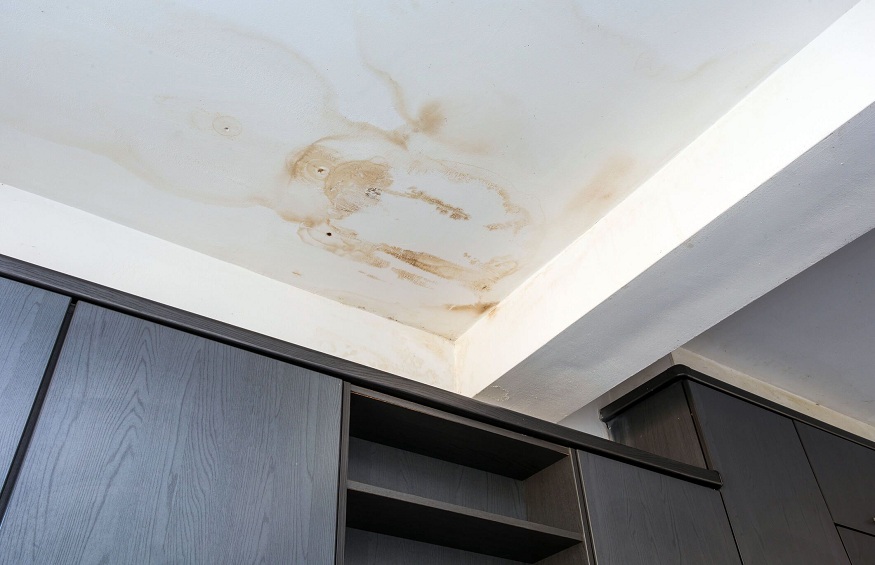Water damage in your ceiling is more than a mere nuisance. It’s a silent alarm for potential structural damage, mold growth, and a host of other issues that can compromise the integrity of your home. This blog post will guide you through understanding, identifying, and addressing water damage in your ceiling, turning a daunting problem into a manageable fix.
Section 1: Identifying the Problem
- Visual Signs: The first step is to look for visual cues. Water stains, discoloration, or paint that’s peeling or bubbling are clear signs of water damage.
- Odor and Mold: A musty smell often accompanies ceiling water damage. If you detect this odor, it could indicate mold growth due to moisture.
- Structural Weakness: Touch the area gently. If it feels soft or crumbles, this suggests the damage has progressed to affect the structural integrity of the ceiling.
Section 2: Tracing the Source
- Roof Leaks: Often, the culprit is a leaky roof. Inspect your roof for missing shingles, cracks, or other damages.
- Plumbing Issues: Water damage can also stem from plumbing problems. Check for leaking pipes, especially if the damage is below a bathroom or kitchen. An emergency water repair is not something you want to have to deal with.
- Condensation and HVAC Issues: Sometimes, the issue is due to condensation from HVAC systems. Ensure these systems are properly maintained.
Section 3: The Cleanup Process
- Safety First: Before beginning any cleanup, turn off electricity in the affected area to prevent electrical hazards.
- Water Removal: Use buckets, towels, or a wet vacuum to remove standing water. The quicker you remove the water, the less damage it will cause.
- Drying Out: After removing the water, use fans and dehumidifiers to dry out the area thoroughly. This step is crucial to prevent mold growth.
Section 4: Repair and Prevention
- DIY or Professional Help: Small areas of damage might be a DIY fix, but extensive damage often requires professional repair.
- Mold Treatment: If mold is present, it may need to be professionally removed to ensure it doesn’t spread.
- Preventive Measures: Regularly inspect your roof and plumbing to prevent future leaks. Consider using moisture-resistant materials if you live in a high-humidity area.
The Silver Lining: A Proactive Approach Tackling water damage in your ceiling is about more than just repairs. It’s about adopting a proactive approach to home maintenance. Regular inspections, timely repairs, and understanding the signs can help you mitigate the risks and expenses associated with water damage. Remember, a proactive homeowner is a prepared homeowner.
Navigating Insurance and Cost Considerations
- Insurance Coverage: Understanding your homeowner’s insurance policy is crucial. Some policies cover water damage, particularly if it’s sudden and accidental. Contact your insurance company promptly to check your coverage.
- Documentation: Document the damage thoroughly with photographs and detailed notes. This documentation is vital for insurance claims and professional repair assessments.
- Cost Analysis: Repair costs can vary widely based on the extent of the damage and the need for professional services. Get multiple quotes and consider the long-term benefits of quality repairs.
Section 6: Health Implications and Safety Measures
- Mold and Health Risks: Prolonged exposure to mold resulting from water damage can lead to respiratory issues and other health problems. Addressing water damage quickly is essential for maintaining a healthy living environment.
- Structural Safety: Significant water damage can compromise the structural integrity of your home. Engage a structural engineer or a professional contractor to assess and address any potential risks.
- Protective Gear: When handling water damage cleanup, wear protective gear like gloves, masks, and goggles to protect yourself from mold spores and other harmful substances.
Section 7: Long-Term Solutions and Upkeep
- Improving Ventilation: Good ventilation helps prevent moisture buildup. Consider installing additional vents or fans, especially in areas like bathrooms and kitchens.
- Regular Maintenance: Conduct regular maintenance of your roofing, plumbing, and HVAC systems to identify potential problems before they lead to water damage.
- Upgrading Materials: If water damage is a recurrent issue, upgrading to water-resistant materials for your ceiling and walls can be a worthwhile investment.
Navigating Through the Drips: Final Thoughts Addressing water damage in your ceiling is a multifaceted process involving identification, cleanup, repair, and prevention. It requires a careful approach, balancing immediate action with long-term solutions. By understanding the causes, taking proactive measures, and responding effectively when damage occurs, you can protect your home and maintain a safe, healthy living environment. Water damage might be a challenge, but with the right knowledge and approach, it’s one that you can confidently overcome.

